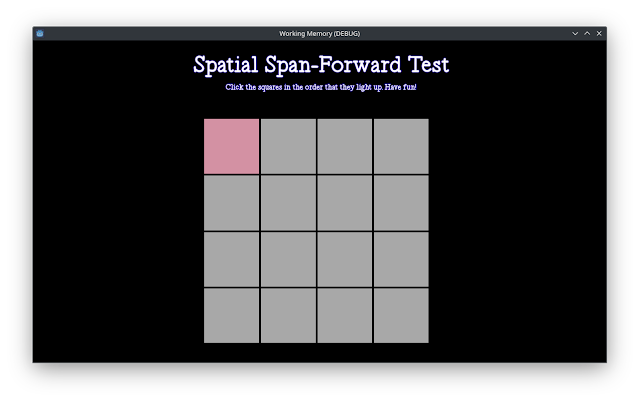As it turns out, the field of neuroscience is chock-full of interesting mechanisms for interrogating our favourite blob of pink meat, the brain. As the proud owner of a human brain, I actually quite enjoy having my senses interrogated. I actively like to have my cognition challenged, poked and prodded. Ok, not literally, but you get the idea.
Well anyway, I hope the same thing applies to you. I took four important tests of working memory (the Digit-Span Forward Task, the Spatial-Span Forward Task, the N-Back Test, and the Letter-Sequencing Test) and implemented them in my favourite game engine. Ten points if you can guess what game engine that is.
As it turns out, most of these are actually kind of... entertaining. As for what they really measure, it's not immediately clear to me. It's a reproducible metric that exists as a contextless point in the vast void of unknowns that is the field of neuroscience. Most of the skills involved in these tasks are not yet pinned down to a particular part of the neurological anatomy, and in my opinion, probably never will be.
Anyway, the purpose of making this game was half-way revision and half-way a challenge to myself to see if I could do it in such a short time. I spent only about three hours (with a break in the middle) to make the whole thing from start to finish. It's fairly unpolished, but most of the games have all the right 'beats'.
In terms of which one is my favourite, I would say the Digit-Span Forward Task (showcased in the video above). That's the only one that felt like a real game, and it's the first one that I set out to work on. In a nutshell, the idea is that the administrator reads out a list of numbers, and the subject just recites them back. Sadly I couldn't add voice recognition into my Godot Engine game (and really, do I want to?!) so I settled for a keypad instead. I settled for some crackly old voice clips of someone reading out numbers in a monotone (specifically created for the Digit-Span Forward Task), rather than recording my own.
The Spatial-Span Forward Task is nearly a duplicate of the Digit-Span task. The only difference between the two is that this one is visual rather than auditory. That being said, unlike the Digit-Span task, this one seemed very much to be missing something. It needed an extra menu, or a bonus effect. It feels a little empty. It ends very quickly when you lose, unlike the Digit-Span test, where the audio will complete itself even if you're staring at the GAME OVER screen. If I were to polish it up, I would most likely go back and add an extra animation before the playable grid disappears. Perhaps I would make the playable grid look better in the first place. An animation to appear, an animation to disappear...
Despite 'polish' having somewhat of a reputation for being the superficial after-thought, it can have a deep and visceral effect on the experience of the game.
The other two had a different set of problems. Perhaps I was getting tired by this point, but upon playtesting, I did not enjoy playing the N-Back Test or the Letter Sequencing Test even one little bit. Who would have thought that tests for neurological ability aren't packed with excitement? Well, this is particularly true for the Letter-Sequencing Test. The task is based around memorizing a list of letters and numbers and then ordering and alphabetizing them. It's not easy to alphabetize a list of 4 or 5 letters, and this game becomes a little exhausting once you play it more than once.
The worst part of the Letter-Sequencing Test is possibly that the interface is quite ugly as well. Maybe. Ok, perhaps I'm being a little harsh on it. But it's true, I don't feel much excitement from the way my screen looks when I'm in the game.
Finally, the N-Back Test has a reasonably attractive interface (though as with all of these games, it could be polished). The big draw, however, is this lovely wide progress bar at the bottom of the screen. It just tells the player how far along in the test they are. The main issue with the N-Back Test, aside from the fact it's also a little bit exhausting of my cognitive abilities, is that I am not entirely sure how to score it! Currently, it's all about "accuracy", i.e., the number of correct answers compared to the number of incorrect answers. However, I've seen more complicated metrics for extracting scores from the N-Back Test, I even saw one that included timing. I'm not that cruel that I would make it a time-sensitive game. However, I'm not sure if my current scoring rubric is doing it any justice at all.
As with all these games, the N-Back Test was never really designed to be a super fun playable experience. I suppose that more than anything, this was only an experiment in some interface design and a little bit of speed-development. I have to say, even though the games are mostly terrible, making them all in only three hours is something I'm quite proud of :D




No comments :
Post a Comment